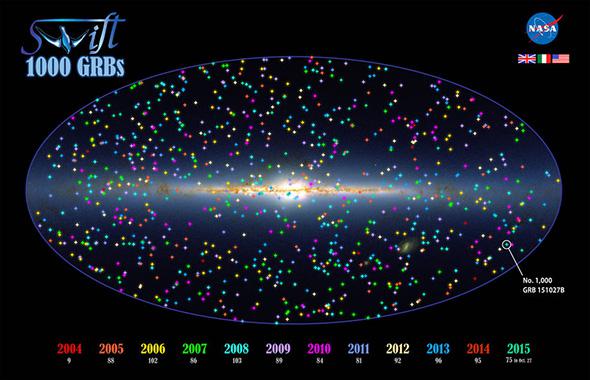I’m kind of in awe over this news: On Oct. 27, NASA’s Swift satellite detected its 1,000th gamma-ray burst!
That’s a lot of bursts.
Swift was launched in November 2004. It’s a relatively small and inexpensive astronomical observatory, designed to detect and rapidly target gamma-ray bursts, or GRBs. These flashes of gamma rays baffled astronomers for decades; they were discovered in the 1960s, and it wasn’t until the 1990s that we finally figured out what they were: unbelievably powerful explosions marking the births of black holes.
I’ve written about GRBs quite a few times; here’s a quick overview that will terrify you about how much energy these hellish objects pack. Also by coincidence, this past week’s Crash Course Astronomy is all about GRBs:
Despite their enormous energy output, GRBs fade so quickly that it’s hard to observe them. Swift was designed specifically to nail down their coordinates in the sky, sometimes as rapidly as seconds after the initial flash. Swift quickly slews over to point its other telescopes at the burst, taking critical observations within a minute or two, and also improving the location measurement. The coordinates are beamed to the ground, sent to telescopes around the planet, which then (if they can) also observe the burst.
Before Swift it could take hours, days, or even weeks to get good follow-up observations of GRBs. Now it takes literally seconds.

Photo by NASA/Swift/Phil Evans, Univ. of Leicester
The lucky 1,000th burst—called GRB 151027B (the second GRB seen on Oct. 27)—is soul-crushingly distant, more than 12 billion light-years away. Most GRBs Swift has seen have been billions of light years away, in fact. That’s how powerful they are; visible across the vast reaches of the Universe.
Swift has shown us that a GRB pops up in the sky nearly every day. That means there are actually far more of them out there than we see! The emission is beamed, focused into a tight jet; we only detect a GRB if that jet is pointed right at us. For every one we see, there are many more pointed the wrong way. And in turn, this means black holes are being born all the time, somewhere in the cosmos.
How’s that for your thought of the day?
I had the privilege of working on the education and public outreach for Swift for several years, helping to write educational activities based on its science, web articles, and more. I wrote a bit about that on the occasion of Swift’s tenth anniversary in space.
Swift is one of my favorite missions of all time. It was brilliantly conceived, carefully built, kept at a low cost, and has worked almost flawlessly for over a decade, doing cutting edge science in a field of astronomy that didn’t even exist when I was born.
That’s quite a legacy. And it’s still going. Congratulations to everyone on the Swift team!
